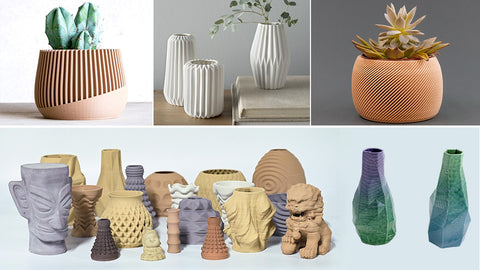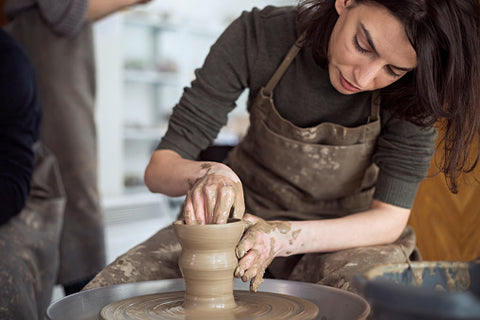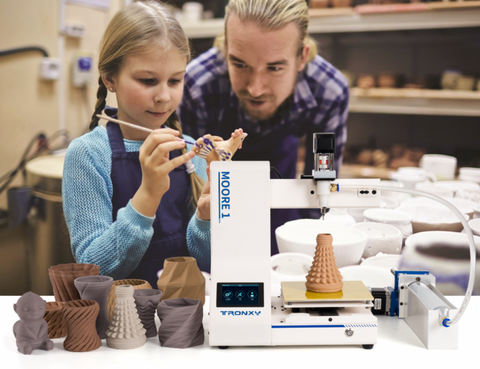Tronxy NEW Clay 3D Printer–2021 New Arrrival
Publié par menglisa le
Many pottery artists feel discouraged when they are thinking about turning their design into pottery and ceramic models. They love potteries and ceramics, and they are very good at designing, but they may not be very good at handmaking. Some teachers/parents want to teach their students/kids to do the 3D model design, get their students/kids familiar with the 3d printing technology. They get frustrated as well. Why? is it not safe enough to use an FDM 3d printer or an LCD 3D printer in class, as an FDM 3D printer has a very high-temperature hot-end. The high-temperature hot end of an FDM 3D printer may cause scalding to the students/kids. The resin used on an LCD 3D printer has a certain degree of toxicity, and it may not be safe enough to be used in some school teaching. Today, we will share with you a NEW 3D clay printer, which print with clay and no hot-end is requited. It is easy for the ceramic enthusiasts and artists to use this 3D clay printer to print potteries and turn their ideas into reality. It is safe for the students to learn the 3D printing technologies and modeling in the classroom.
Pottery and ceramic were invented before 2000 BC, and they had a wide range of uses. They are often used to hold food and store goods. The invention of pottery is an important symbol of human civilization. There are some problems in traditional pottery production, such as a lot of human resources and time. The appearance of finished products is easily limited, which can not meet the personalized and diversified needs of contemporary aesthetics. With the development of science and technology, we can use 3D clay printers to print potteries and make ceramics.

Handmade Pottery and Ceramic

Ceramic and Pottery Printed by 3D Printer
What is a clay 3D printer?
Clay 3D printing technology, according to the principle of fluid deposition molding, the semi-fluid clay material is extruded through the pipe into the printhead (mechanically or pneumatically ). The printhead moves along the profile and forms layers of the model. Through spirally accumulating clay layer by layer, the clay is bonded and molded into a three-dimensional structure.
It only needs the user to establish the initial model data in the computer, and the printhead can complete the model according to the generated path. This new method of 3D printing has the advantages of simple process, simple operation, fast forming speed, etc.
What are the similarities and differences between clay 3D printers and FDM printers using filament?
Similarities: like FDM 3D printers, clay 3D printers move according to computer instructions and deposit material layer after layer to create 3D shapes.
Differences: The filament used in the FDM 3D printer is solid and thermoplastic, which needs to be heated to become in a fluid state before printing. A “hot end” needs to be installed on the extruder of the FDM 3D printer. In addition, the consumables used by FDM printers generally cannot be reused.
The 3D clay printer uses high viscosity clay as raw material. Clay is a natural soil material. We only need to add water to the clay and mix it into a fluid state. In addition, this clay is reusable. after printing (a printed model) can also be used to reprint after being humidified by adding water.
The 3D clay printer has a particular mechanical feeding and extrusion system. It transports the clay from the barrel to the extruder and then extrudes it through the nozzle from the print head. Nozzles are usually interchangeable to accommodate extruded clay of different thicknesses.

The handmade pottery and the pottery printed by the 3D clay printer:
When making pottery by hand, we should always pay attention to the rotation speed of the rotating wheel, the movement of the hand, the stability of strength, etc. In this process, the movement of hands and fingers is the direct source of creativity, which determines the final shape of the pottery. It is complex, time-consuming, and has a low success rate. Many pottery lovers can only appreciate its beauty and dare not easily make pottery by themselves at home.

making pottery by hand
The clay 3D printer uses the original clay material, which is easy to gain and low cost. It is more suitable for most ceramic lovers to carry out 3D printing pottery creations. With this 3D clay printer, users do not need to consider the printhead temperature and ambient temperature. For beginners of 3D printing, they will have a higher success rate.
Users of the clay printer:
Today, clay 3D printers are mainly used in education, cultural creation, art sculpture, family handicraft lovers, and other fields. This kind of 3D clay printer is quite popular in education. For beginners interested in 3D printing, family education, and school education, it is an enlightening 3D printer and a valuable helper for pottery and ceramic lovers to realize their design ideas.

Many schools have introduced ceramic 3D printers, which are mainly used in the teaching and experimenting model design and production of industrial design. 3D technology is more in line with the hobbies of “post-80s” and “post-90s” who like to complete operations on computers. Their designs can be printed into physical models in just half a day, saving at least half the time compared with traditional ceramic production.
It is also more convenient for designers to modify the model, experiment, and verify the feasibility of their design.
Range of use of 3D clay printers:
To make pottery and other functional utensils. It plays a prominent role in reproducing and restoring pottery ceramic relics.
To make Vases and other art sculptures: clay 3D printers can also make vases, portraits, and other aesthetic items for artistic display and home decoration.
To allow more ceramic lovers and more students to use 3D printers at a low cost, we have launched a new clay 3D printer. This clay printer is easy to use, accurate, and it prints fast. It is an economical 3D printer
The clay 3D printer has a nozzle diameter of 1.0mm-3.0mm, a build size/printing size of φ 180 × 180mm, a maximum printing speed of 40mm/S, and a printing accuracy of 0.3mm.
What are the main technical highlights of this 3D clay printer?
1. with mechanical feeding and extrusion system, no extra air compressors is required
2. with function of power-off and continuous printing, it can improve the success rate of printing.
3. with emergency stop function and no need print bed laveling, it is safe and more easy to use.
4. with a 3.5-inch touch screen interface, easy to operate.
5. Super mute motherboard, you can use it at home without affecting others’ working and resting.
Advantages of Tronxy 3D clay printer:
1. More easier to operate it. Compared with the FDM 3D printer, the clay printer is easier to operate because it is more convenient and easy to print in terms of platform leveling, temperature setting, and printing material selection. In addition, this clay printer can be used alone and does not require an air compressor.
2. Print fast. 3D clay printers print 80% faster than 3D filament printers
3. Print accurately. Its mechanical accuracy is up to 2mm. We provide 0.2~5mm nozzles with different diameters.Printing materials are safe and easy to obtain.Clay is cheap and environmentally friendly. The raw materials do not have any chemical additives, so it is suitable for the creative production of daily ceramics, home decoration items, etc.
Will 3D printing replace traditional ceramic technology?
Though with complex modeling ability, high efficiency, and high accuracy, 3D clay printers will not replace the traditional ceramic technology in a short time. For now, we can see 3D clay printing as a supplement to conventional ceramic technology.
3D printing opens up interesting new possibilities for clay molding, but it is too limited to copy some manual techniques.
For hand-made ceramics, their surface is mainly smooth inside and outside. But the ceramic surface printed by a 3D printer will have layers of lines.
Some people will think that the layer patterns in 3D printing are a “defect” that needs to be remedied or improved. Why does the surface of ceramic products have to be smooth? Ceramics with lines and various surface shapes can be regarded as the expansion of ceramic product form, which meets the needs of personalization and diversification of people in modern society.
We can also regard this layer pattern as an advantage and innovation. 3D printing can print a variety of unexpected texture effects on the surface of the model.
People have been using their hands to experience and feel the clay with wisdom and create a ceramic culture for a long time. With the development of science and technology, we have 3D ceramic printers. We can use the power of science and technology to help us better create, inherit and experience the beauty of potteries and ceramics.
← Message plus ancien Message plus récent →
2 commentaires
-
I18n Error: Missing interpolation value "auteur" for "{{ auteur }} le {{ date }}"
What is the cost going to be and can I review it for you???

extra cool